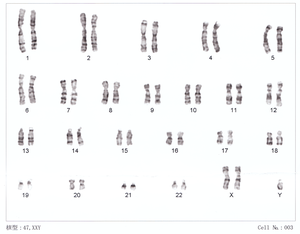47,XXY
| Klinefelter syndrome | |
|---|---|
| Synonyms | XXY syndrome, Klinefelter's syndrome |
 |
|
| 47,XXY karyotype | |
| Pronunciation | |
| Specialty | Medical genetics |
| Symptoms | Often few |
| Usual onset | At birth |
| Duration | Long term |
| Causes | Two or more X chromosomes in males |
| Risk factors | Older mother |
| Diagnostic method | Genetic testing (karyotype) |
| Treatment | Physical therapy, speech and language therapy, counselling |
| Prognosis | Nearly normal life expectancy |
| Frequency | 1:500 to 1:1,000 males |
| Classification |
· ·
|
|---|---|
| External resources |
Klinefelter syndrome (KS) also known as 47,XXY or XXY, is the set of symptoms that result from two or more X chromosomes in males. The primary feature is sterility. Often symptoms may be subtle and many people do not realize they are affected. Sometimes symptoms are more prominent and may include weaker muscles, greater height, poor coordination, less body hair, smaller genitals, breast growth, and less interest in sex. Often it is only at puberty that these symptoms are noticed. Intelligence is usually normal; however, reading difficulties and problems with speech are more common. Symptoms are typically more severe if three or more X chromosomes are present.
Klinefelter syndrome usually occurs randomly. An older mother may have a slightly increased risk of a child with Klinefelter syndrome. The condition is not inherited from one's parents. The underlying mechanisms involves at least one extra X chromosome in addition to a Y chromosome such that there is a total of 47 or more chromosomes rather than the usual 46. KS is diagnosed by the genetic test known as a karyotype.
While there is no cure, a number of treatments may help.Physical therapy, speech and language therapy, counselling, and adjustments of teaching methods may be useful. Testosterone replacement may be used in those who have significantly lower levels. Enlarged breasts may be removed by surgery. About half of affected males have a chance of fathering children with the help of assisted reproductive technology, but this is expensive and not risk free. Males appear to have a higher risk of breast cancer than typical but still lower than that of females. The condition has a nearly normal life expectancy.
...
Wikipedia
